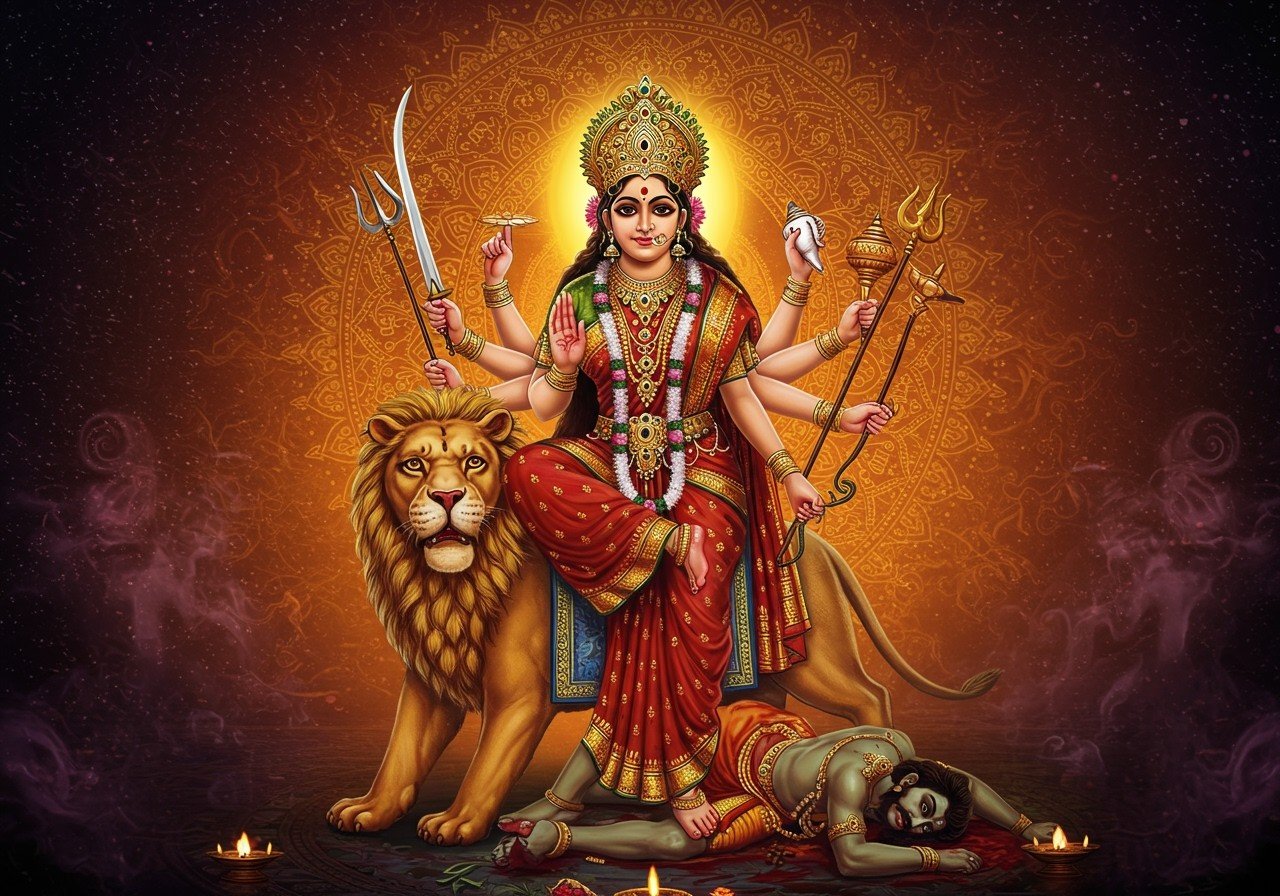
Goddess Durga holds a special place in Hinduism as a symbol of strength, protection, and compassion. She is deeply revered, especially during the Navratri festival, where her victory over evil is celebrated. Her stories and significance continue to inspire many, reflecting ancient traditions and spiritual beliefs that are cherished by middle to upper-middle-class Indians who value tradition. For those seeking to connect with the divine feminine, explore the rich traditions associated with Durga Puja in Kolkata here.
Who is Durga Devi?
The name ‘Durga’ means ‘the invincible‘ or ‘the one who eliminates suffering‘. She embodies divine feminine energy, also known as Shakti or Devi, and is a principal aspect of the mother goddess Mahadevi. As a warrior goddess, Durga combats evils and demonic forces, ensuring peace and prosperity, and upholding dharma. Legends depict her as a beautiful woman, often riding a lion or tiger, with multiple arms, each wielding a divine weapon.
In mythology, Durga was created by the gods to defeat the demon Mahishasura. Born from the combined powers of Brahma, Vishnu, and Shiva, she received their weapons, becoming invincible against any male. This origin story highlights the power of good over evil and exemplifies her protective nature. Learn more about the protective mother Goddess Lakshmi and the goddess of knowledge Saraswati. These deities, along with Durga, represent essential aspects of divine feminine energy.
Depictions and Symbolism of Durga
Durga’s iconography is rich with meaning. Her ten arms, each holding a weapon gifted by a god, symbolize her diverse powers. The lion she rides represents courage and strength, while her various names reflect her protective and militant nature. She is known as Durgatinashini, meaning “the one who eliminates sufferings,” reinforcing her compassionate role as the protector of the universe.
In art, Durga is often depicted riding a lion or tiger, poised for battle. This portrayal signifies not just physical strength, but inner courage and resilience. Her weapons represent various virtues like self-discipline and devotion. She is a striking figure, often shown in the midst of battle, especially in the moment of her victory over Mahishasura.
Durga as the Mother Goddess
Durga Devi is more than a warrior; she is revered as the mother of the universe in Hindu cosmology. She embodies Shakti, the divine feminine energy. Her different forms, such as Kali, Parvati, and Ambika, highlight various aspects of her nature, reflecting her role in protecting, nurturing, and empowering the universe.
For a deeper understanding of Kali, explore our resources on Maa Kali, the protector, and Kali Ma devotion.
Durga Maa: The Nurturing Mother
The term ‘Maa’ emphasizes Durga’s nurturing side. Devotees view her as a benevolent figure who cares deeply for her children, offering protection and solace. Stories of Durga Maa often depict her shielding her children from harm, reinforcing her compassionate nature.
She is celebrated during Durga Puja, a festival of gratitude and devotion where people seek her blessings. This celebration reinforces the strong bond between the goddess and her devotees, highlighting her maternal love and protection.
Durga Mata: The Protector and Guardian
‘Mata’ also signifies ‘mother’ in many Indian languages, further underscoring Durga’s maternal role as a protector. Stories of Durga Mata, particularly those originating from different regions, highlight her wisdom and power to intervene in human affairs to aid her devotees.
During Navratri, rituals and customs honor Durga Mata, with devotees fasting, praying, and making offerings seeking her blessings for prosperity and well-being. In family traditions, she holds a special place as a guardian of happiness and success, further emphasizing her nurturing and protective qualities. You can find essential items for Durga Puja, like complete Dashakarma kits, on Poojn.in.
Stories and Significance of Goddess Durga
Durga’s battle with Mahishasura, a powerful demon, exemplifies the triumph of good over evil. This tale resonates with many, inspiring them to overcome their own challenges with courage and determination.
Her victory over Raktabija is another prominent story, demonstrating her power and resourcefulness. These stories, rich in symbolism, teach valuable lessons about virtue and resilience.
Durga symbolizes strength and empowerment, particularly for women, representing courage and justice. Spiritually, she embodies the protection of righteousness and the eradication of evil. Her festivals, including Navratri and Durga Puja, use music, dance, and rituals to celebrate her. These events strengthen community bonds and preserve cultural identity.
Poojn.in: Your Resource for Durga Puja
Poojn.in, India’s largest Dashakarma bhandar, provides authentic puja items and materials to enhance your Durga Puja observance. We offer a wide selection of products, including complete Durga Puja samagri kits, pure brass and copper Durga idols, traditional Durga yantra and chalisa, and more.
We also offer specific items like Dasha Mrittika (ten types of clay) and Sapta Jal (seven holy waters) for Mahasnan, ensuring your rituals are performed authentically.
Enhance your spiritual experience during Navratri with our Khager pen and kolom for Saraswati Puja. For offerings, consider our Char Magaz (watermelon seeds). Additionally, our pure Nil Nal blue powder is perfect for traditional rituals.
Conclusion
Goddess Durga embodies strength, love, and protection. Her narratives and symbolism emphasize courage, righteousness, and maternal care. Celebrating her through festivals like Navratri and Durga Puja reinforces these timeless values. Durga empowers us to face life’s challenges with resilience and embrace our inner strength. By understanding her significance in our cultural and spiritual lives, we deepen our connection to tradition, striving for balance, empowerment, and peace.

